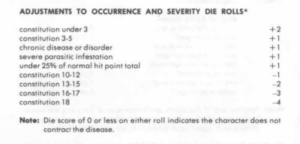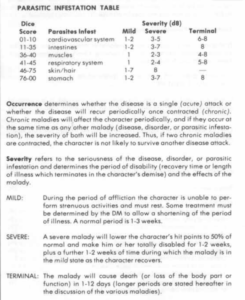The rules for diseases in AD&D are great, but you probably rarely use them because they are such a niche subgame and hard to track. Let’s cover the basics, then clear that first hurdle first, then go back and look at the disease rules in a more detail.

Generally speaking, you check once per month for diseases and once per month for parasites. Check once a week if you are in a fetid swamp, or you live in filthy squalor, or you paid a little visit to the Harlot Table.
If you’re playing conventional ‘stop time’ D&D, this becomes a hassle to recall and implement. The three week campaign that 5e players lament so often wouldn’t even register on this time scale. If you hit the fast-forward button, you might have to remember to check once or twice or have some uncertainty when exactly to check or you have different characters checking at different times or… the list of excuses goes on and on.
In Jeffrogaxian timekeeping campaigns, it gets a whole lot easier and a whole lot smoother. As with upkeep (100 gp/level) this is a regular event and part of your monthly check-up. You pay upkeep and check diseases on the first of every month. Takes no time at all to rationalize or justify. As with so many other things, you can always delay the bill coming due for a few days, to let your PC get back to town, or handwave away partial payments of upkeep and the random nature of disease to delay paying the price for catching something Faucian while out on a delve.
Score another win for Jeffrogaxian timekeeping.

And what a win this is. It unlocks a lot of different flavors of game. For once thing, it up-guns the paladins and unlocks a host of uses for those healbots you call clerics.
Every month your PC has a 1 in 50 chance of contracting disease followed by a 3 in a hundred chance of catching a parasite. Run those numbers and you’re looking at about a 1 in 20 chance of catching something nasty. Under normal conditions a party of five will see somebody is catching something once every quarter of the year.
Some people – the bad people – think this is a problem that slows play and not what heroic adventuring gaming is all about. These are the sorts of people who fail to recognize that every obstacle is not getting in the way of journey, it IS the journey. Diseases open up so many possibilities that they regularly appear as ‘power-ups’ for monsters like rot grubs, mummies, and the humble giant rat.
As a brief aside, if you’re not using disease checks, you’re nerfing this little 1/2-hit die critters. Repeated bites should cause repeated checks for disease, and some of these diseases can be nasty.
The disease table is very similar to the parasite table shown above, but they share game effects. First you roll to determine the type, then the severity. Even a mild case of myocarditis will put you out of the game for 1-3 weeks. That’s a lot of time to be flat on your back when you’ve got a 100gp/month bill due soon. A severe case of the flu can wreck a first level character as sure as getting squarshed by a giant.
Fortunately, there are plenty of ways to mitigate the dangers. All of them feature tradeoffs, mind you, but these sorts of risk/reward decisions are baked into the gaming cake. These kinds of choices make the game interesting in a way that not playing the game just isn’t.
We already mentioned Paladins, but their ability to heal disease is a once per week power. Gary didn’t leave us hard and fast rules for how Paladins cure diseases through faith and God’s love, but we do have some coded out in the cleric spell cure disease. (It’s worth noting that spell is a third level spell locked away behind a whole lot of XP. You gotta earn your way out of the sewers of germs and parasites.) Cure disease helps mitigate the effects, but even with a prescription for Aragorn’s Used Chewing Tobacco, you’re still going to spend some time laid up recuperating. On the plus side, it explicitly works on disease AND parasites, so that’s a nice bonus.
It’s probably better to not get deathly ill in the first place, and for that you can invest in some Constitution. This benefit isn’t listed in the PHB, but a good CON score can keep you from paying a visit to the sick ward. Check it out:
 Those modifiers are for the severity roll, meaning that a constitution of just 10 will help you avoid most terminal cases and a CON of 18 turns all but the worst cases into mild bouts. But protecting yourself from disease comes at a cost of not plugging that high ability score into some other stat. You can be anything, but you can’t be everything.
Those modifiers are for the severity roll, meaning that a constitution of just 10 will help you avoid most terminal cases and a CON of 18 turns all but the worst cases into mild bouts. But protecting yourself from disease comes at a cost of not plugging that high ability score into some other stat. You can be anything, but you can’t be everything.
But there is another way. Gary leaves the door open for other methods of healing – he’s read to much literature not to recognize the value of a ticking viral clock. If your PC pricks her thumb on a Lockjaw Rose and falls into a slumber, those long periods of convalescence give your campaign breathing room for quests to recover that rare and magical ingredient that will save her life or even halve her recovery time. This little mini-game is an adventure creator in its own right.

And we haven’t even touched on how much more menacing a Death Cult of the Disease God becomes when they can weaponize this table against your campaign. If your imagination isn’t churning away already, you might be in the wrong hobby.
You’d be a fool not to recognize and implement the disease mini-game in your campaign – of any edition of D&D – tonight!


